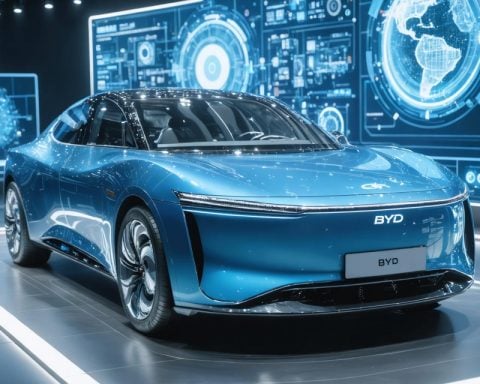- BYD, a leading Chinese EV manufacturer, is pioneering the shift to all-solid-state batteries (SSBs), aiming to revolutionize energy storage and performance.
- SSBs use solid electrolytes instead of liquid, enhancing safety and boosting energy density, leading to faster charging and more stable operation.
- The initial rollout of BYD’s SSB-equipped vehicles is set for the next two years, with plans for large-scale adoption within five years.
- SSBs promise increased driving range and reduced charging times, addressing key concerns of EV owners.
- Competition is heating up as CATL also pursues SSB technology, indicating a major transformation in the battery industry.
- The future of transportation looks promising with the anticipated mass production of SSBs, paving the way for a sustainable and high-performing electric vehicle era.
In a groundbreaking move, a leading Chinese electric vehicle manufacturer has taken a decisive step toward transforming the EV landscape. BYD is poised to unveil vehicles equipped with all-solid-state batteries (SSBs), heralding a new era of energy storage. With solid electrolytes replacing the liquid ones in conventional lithium-ion batteries, these new cells promise enhanced safety and remarkable performance advancements.
Picture a future where cars charge at lightning speed and drive with unparalleled efficiency. BYD’s latest innovation embraces sulfide-based solid-state technology, which not only boosts energy density but also assures faster recharging and more stable operation for high-end vehicles. Over the next two years, BYD plans to roll out its first EVs featuring these state-of-the-art batteries in a limited release, allowing them to fine-tune and perfect the technology.
The vision does not stop there. Within five years, BYD aims to have this revolutionary technology adopted on a large scale, potentially altering the EV industry’s dynamics. The anticipation surrounding solid-state batteries stems from their substantial promise of increasing the driving range while cutting down charging times, a vital concern for EV owners.
BYD, the world’s second-largest battery producer, is not the only player in this ambitious pursuit. Competitor CATL is also eyeing the shift, indicating a forthcoming wave of transformation in battery technology. As battery titans race to embrace SSBs, the electric vehicle revolution is set not just to accelerate but to leap into a future marked by sustainability and unparalleled performance.
With a brighter, faster, and safer journey on the horizon, the transport industry stands at the brink of an exciting evolution. As SSBs edge closer to mass production, they promise not just progress, but a revolution in how we envision travel. The future is electric, solid, and remarkably bright.
Revolutionizing the EV Landscape: Is BYD’s Solid-State Battery a Game Changer?
How-To Steps & Life Hacks
1. Understanding SSBs: Solid-state batteries (SSBs) replace the liquid or gel electrolyte typical in lithium-ion batteries with a solid electrolyte. This design minimizes the risk of leaks and fires, promising to enhance safety and increase battery life.
2. Maximizing SSB Potential in EVs: To harness the full potential of SSBs in electric vehicles:
– Optimize Charging Infrastructure: Install faster chargers that can handle the higher density and unique charging profile of SSBs.
– Adjust Driving Habits: Familiarize yourself with the efficiency of SSBs, enabling more eco-friendly driving strategies.
– Maintenance: While SSBs are more stable, regular check-ups will ensure optimal performance and longevity.
Real-World Use Cases
– Automotive Industry: Beyond EVs, SSBs could power electric buses and trucks, where enhanced safety and performance are crucial.
– Consumer Electronics: SSBs might revolutionize the battery life and safety of smartphones and laptops.
– Renewable Energy Storage: They offer a promising solution for large-scale storage in solar and wind energy setups.
Market Forecasts & Industry Trends
– Growing Demand: The global solid-state battery market is anticipated to reach USD 6.8 billion by 2030, driven by automotive and consumer electronics sectors.
– Industry Giants: Apart from BYD and CATL, companies like QuantumScape and Solid Power are leading the charge, highlighting a competitive trend towards widespread adoption.
Reviews & Comparisons
– Performance vs. Traditional Batteries: Users note significantly higher energy density and faster charging with SSBs. However, they currently face challenges in manufacturing scale and cost.
– Comparative Analysis: SSBs outperform traditional lithium-ion batteries in safety and longevity but are still more expensive.
Controversies & Limitations
– Manufacturing Challenges: The complexity and high cost of production remain significant hurdles.
– Scalability Issues: Transitioning from prototype to mass production is a major industry bottleneck.
Features, Specs & Pricing
– Energy Density: SSBs virtually double the energy density compared to conventional batteries.
– Safety Profile: With non-flammable solid electrolytes, they offer enhanced thermal stability.
– Price Point: Initially higher than traditional batteries, costs are predicted to fall as production scales.
Security & Sustainability
– Eco-Friendly Production: SSBs reduce toxic components, offering a greener alternative.
– Lifecycle Efficiency: They promise a longer lifespan, reducing waste over vehicle lifetimes.
Insights & Predictions
– Industry Shift: Experts predict SSBs will command up to 30% of the battery market by 2030, driven by EV adoption and performance benefits.
– Environmental Impact: As production becomes more sustainable, SSBs could significantly lower the carbon footprint of battery manufacturing.
Tutorials & Compatibility
– Integration: Ensuring vehicle systems are tailored for high-voltage, high-density SSBs is crucial for seamless integration.
– Retrofit Potential: While new models are likely to emerge, retrofitting existing EVs remains challenging due to compatibility issues.
Pros & Cons Overview
Pros:
– High energy density
– Quick charging
– Enhanced safety
– Longer lifespan
– Eco-friendly
Cons:
– High initial cost
– Manufacturing complexity
– Scalability challenges
Actionable Recommendations
1. Invest in Research: Understanding solid-state technology now can position you strategically as trends evolve.
2. Infrastructure Preparation: Upgrade EV charging stations to accommodate faster charging capabilities.
3. Stay Informed: Follow industry leaders like BYD and QuantumScape for the latest developments.
For more information on EV advancements, visit BYD.
—
With solid-state batteries poised to transform energy storage, understanding this shift is crucial for anyone invested in the future of electric vehicles and energy sustainability.








